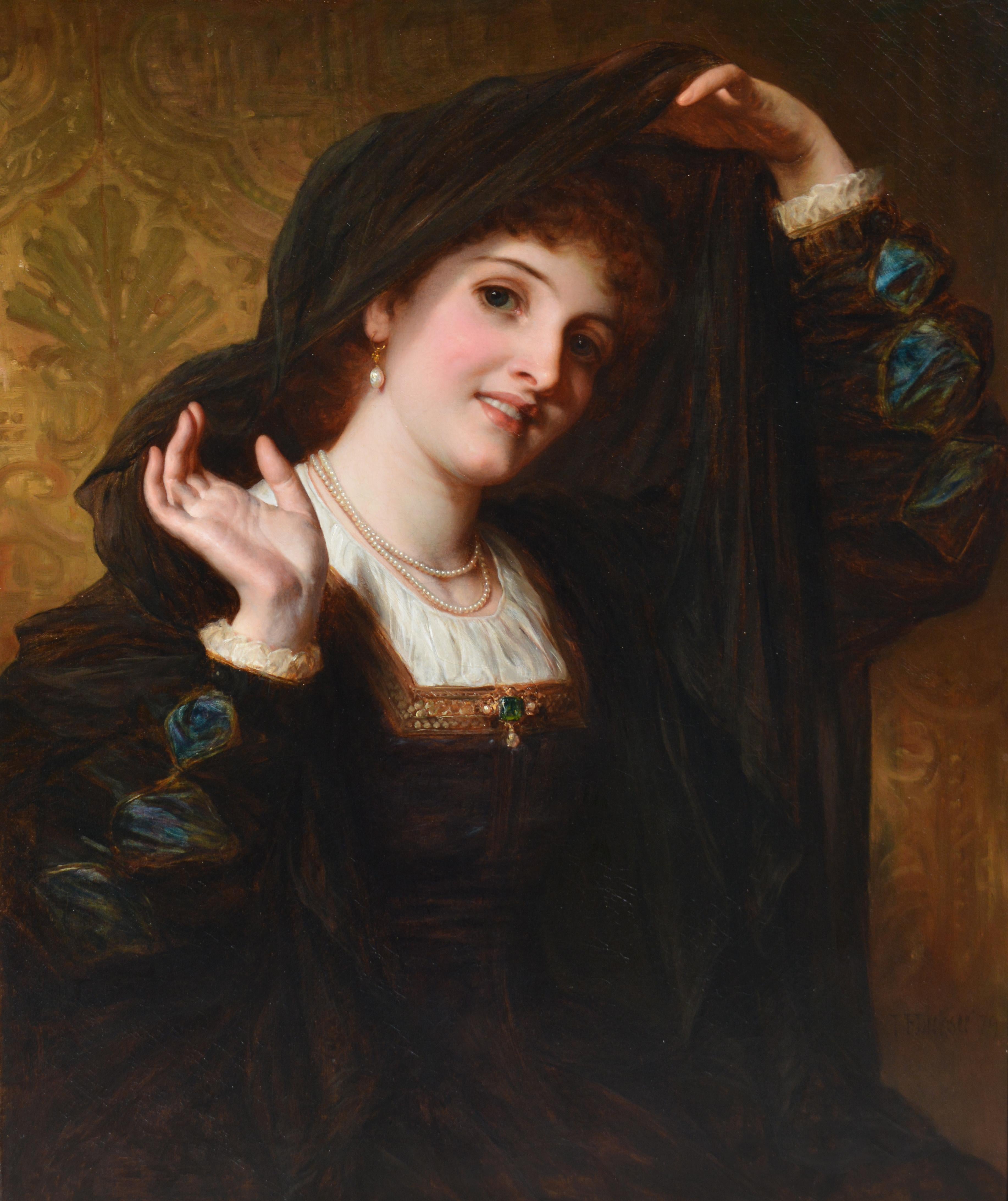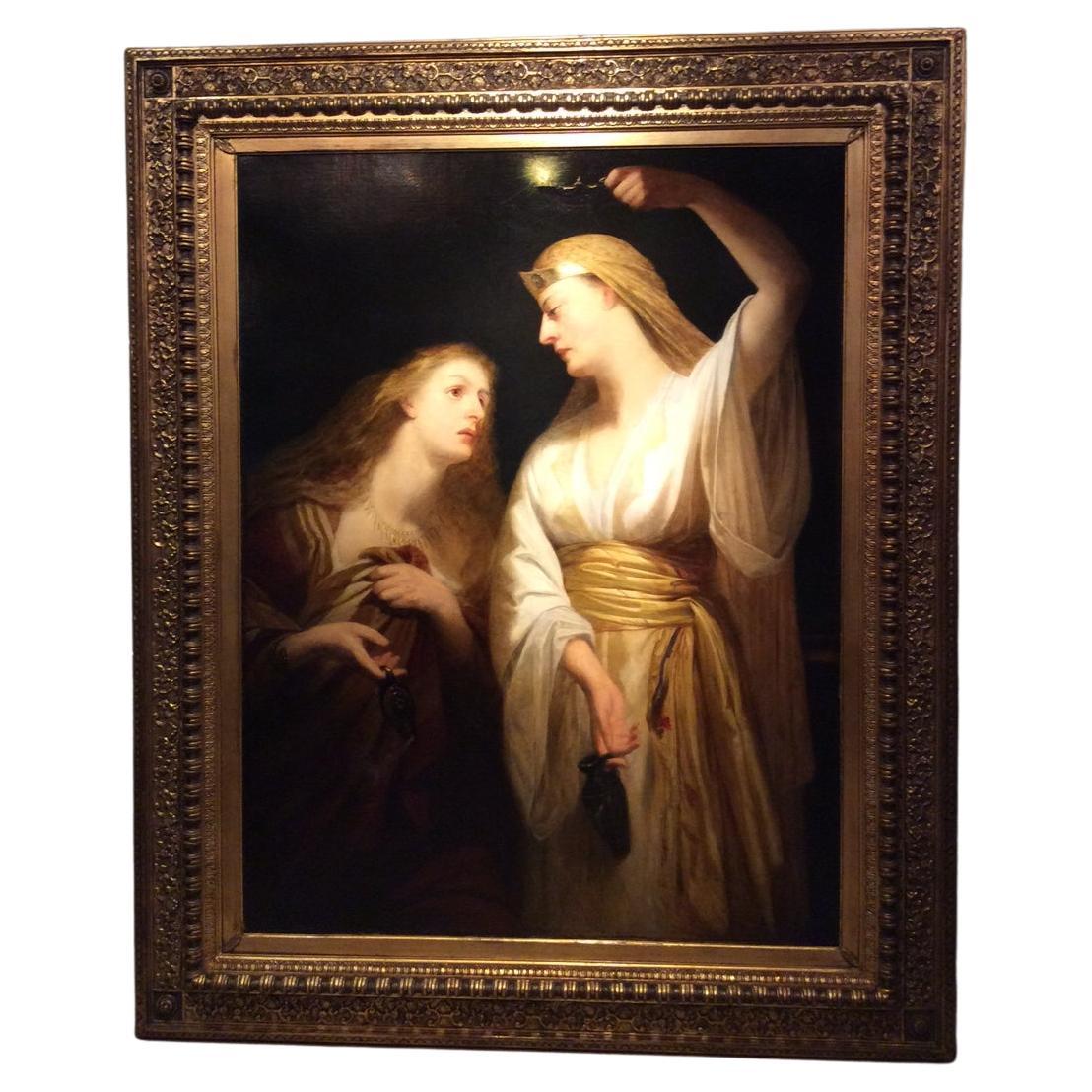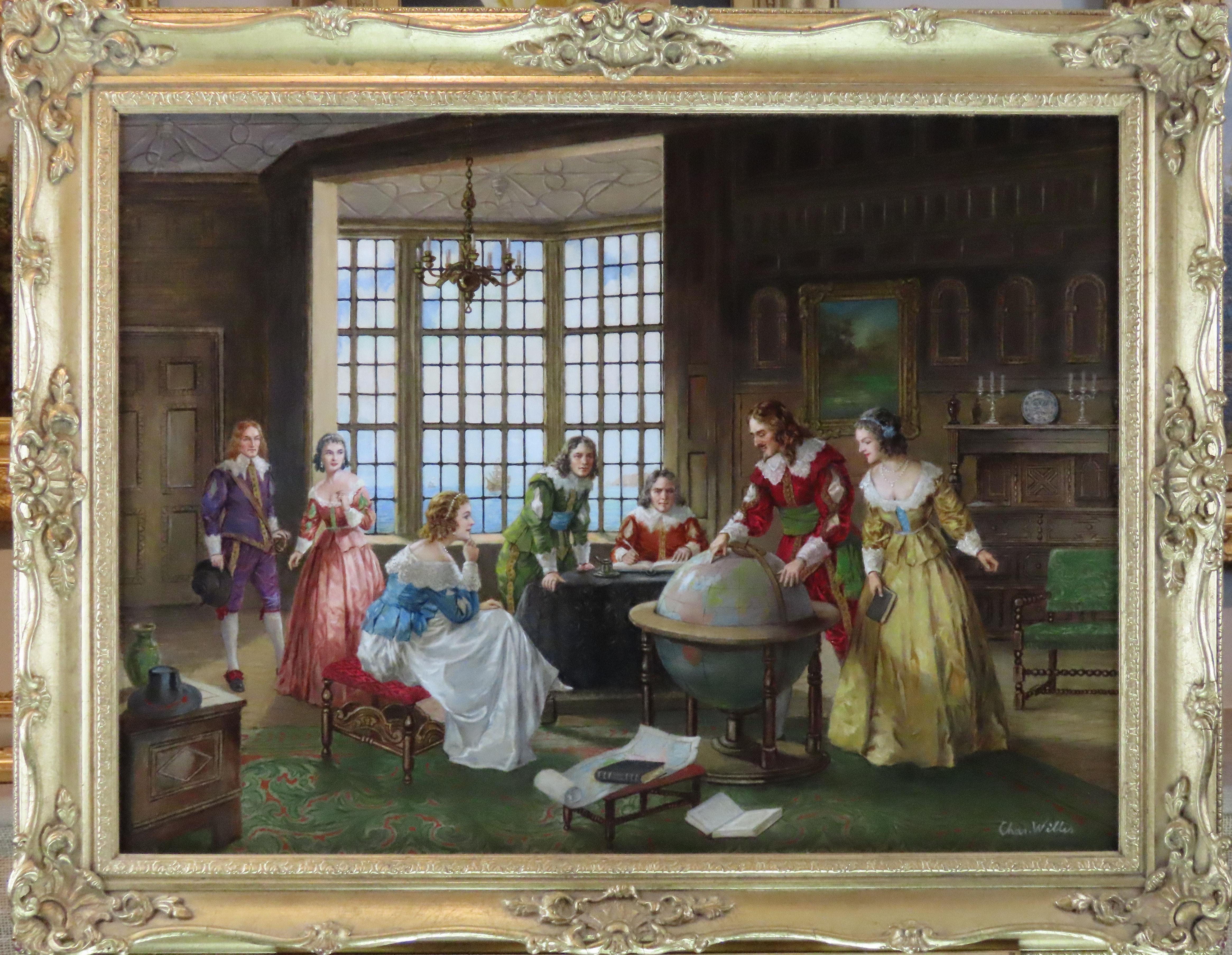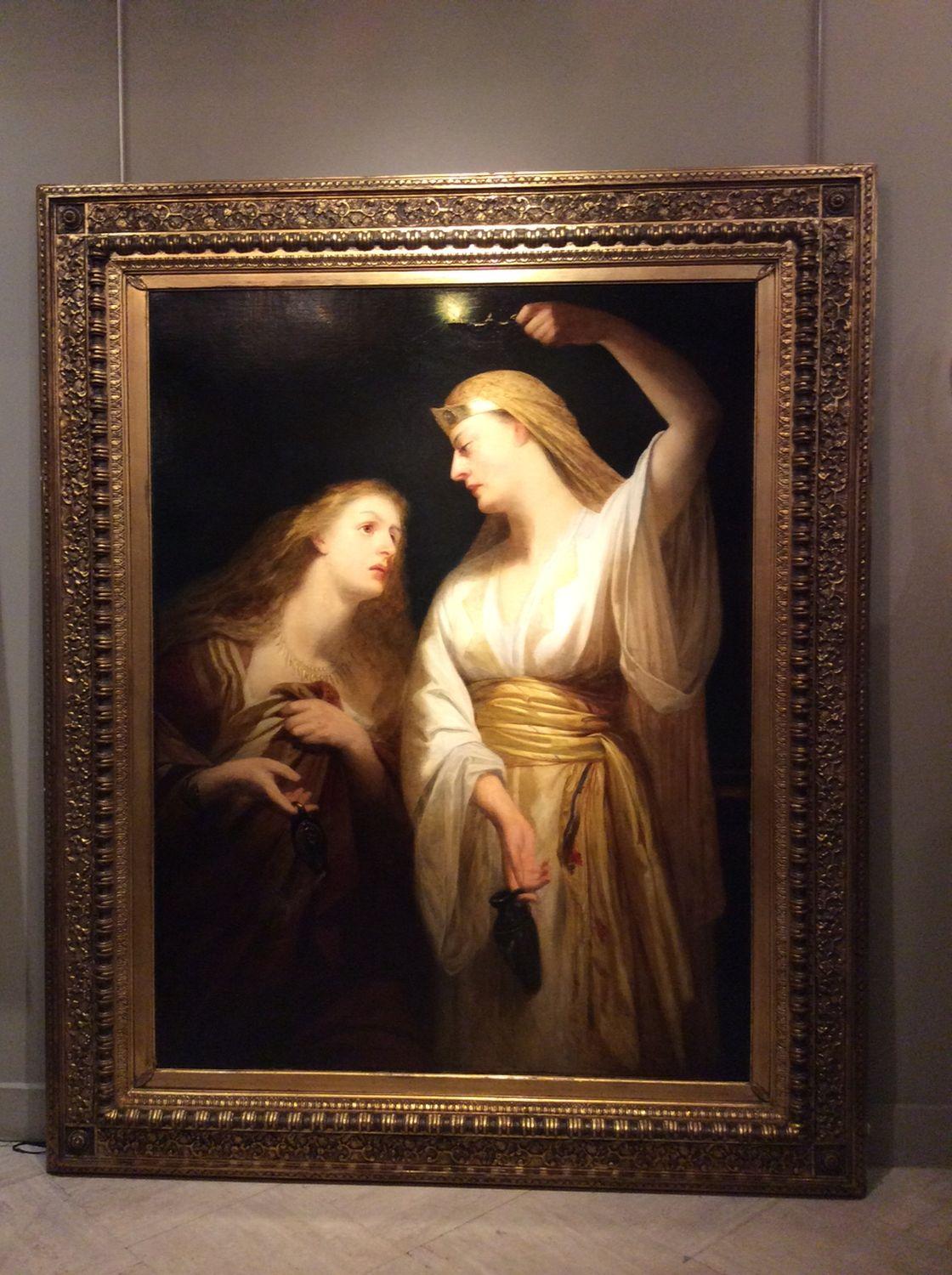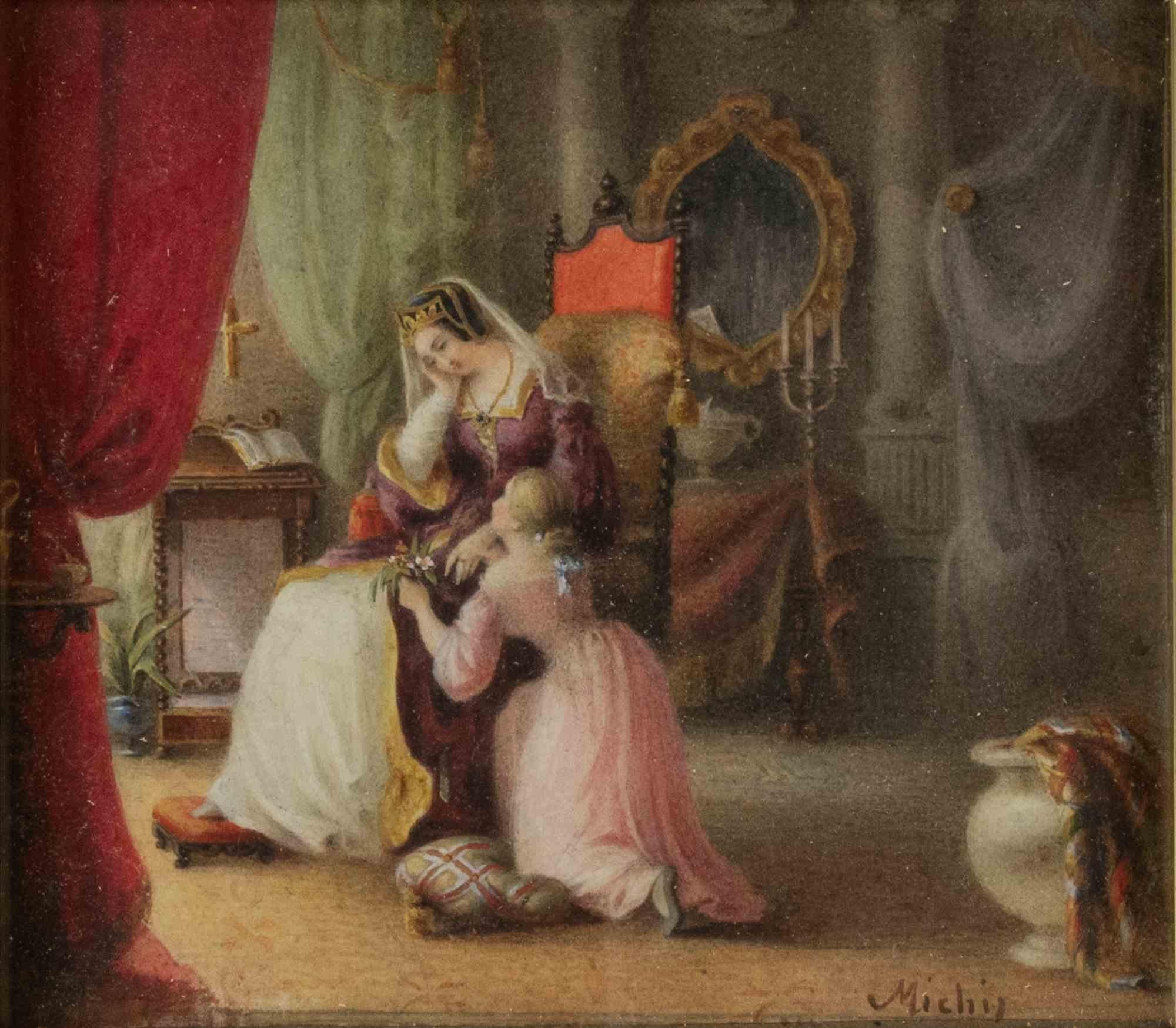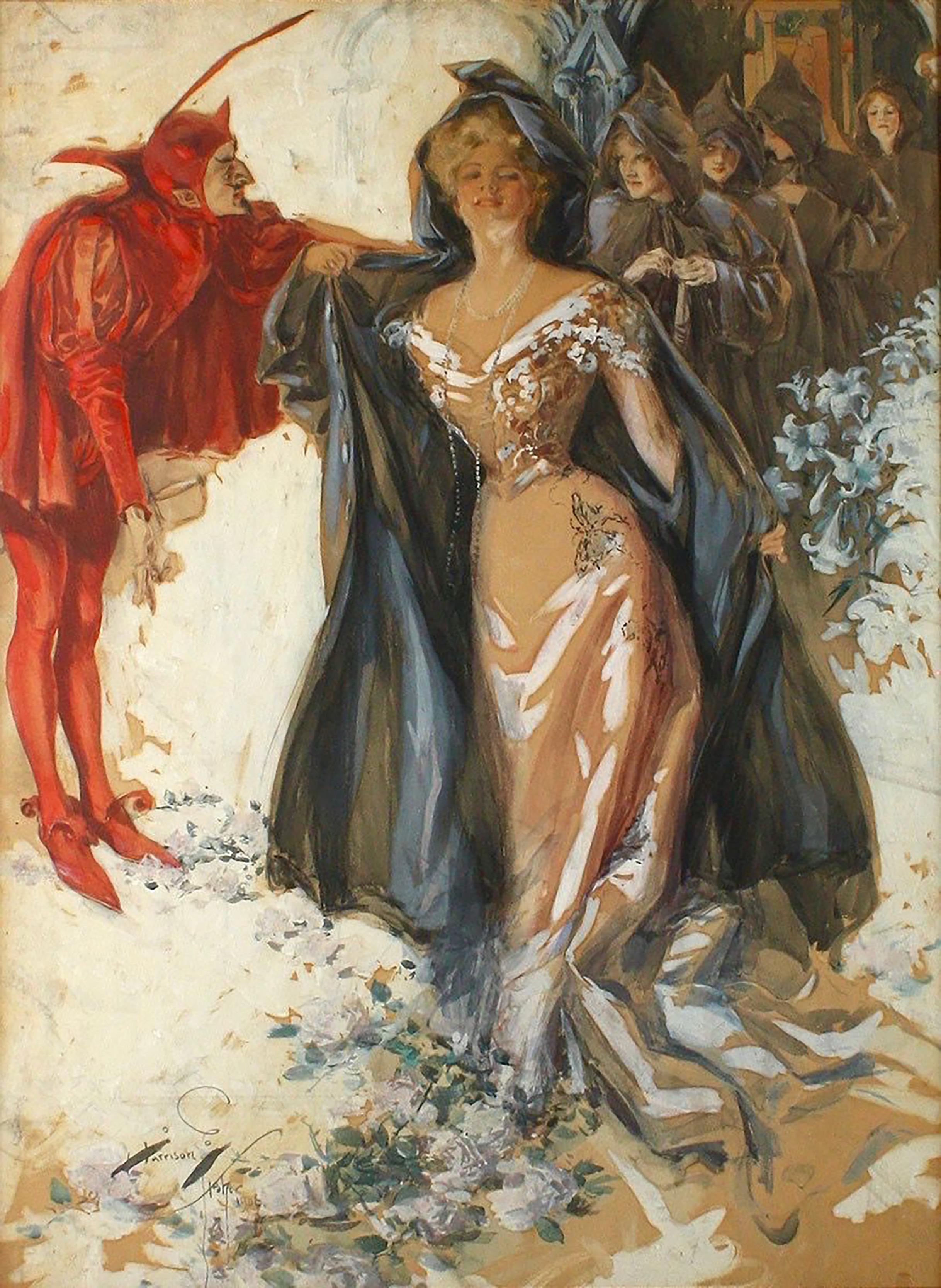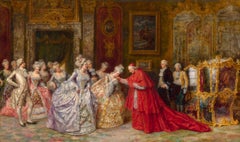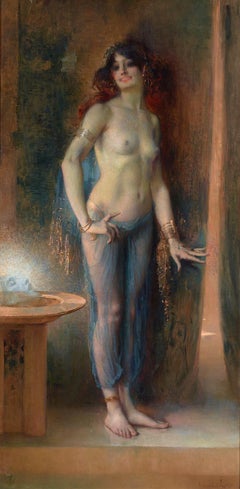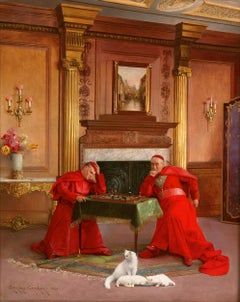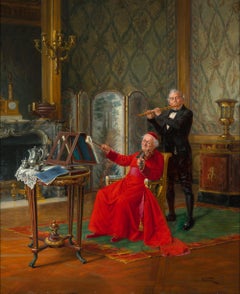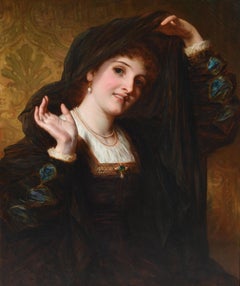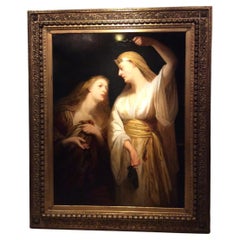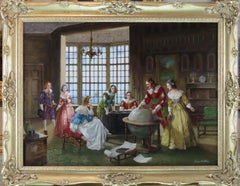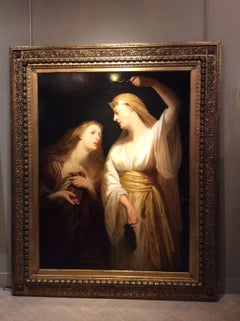Items Similar to The Twelve Princesses
Want more images or videos?
Request additional images or videos from the seller
1 of 10
Gustave-Max StevensThe Twelve PrincessesDated 1899
Dated 1899
Price Upon Request
Price Upon Request
Price Upon Request
Price Upon Request
Price Upon Request
Price Upon Request
Price Upon Request
Price Upon Request
Price Upon Request
Price Upon Request
About the Item
The greatest triumph of the artist’s career, this extraordinary and monumental oil on canvas by Gustave-Max Stevens perfectly represents the highly detailed compositions and richly hued palettes championed by the Pre-Raphaelite Brotherhood. The composition’s larger-than-life-size, brilliant coloring and myriad details enhance the drama of its subject, the Grimm Brothers’ fairy tale, The Twelve Princesses. The artist exhibited this work extensively, including at the 1901 Paris Salon, testifying to both the artist’s regard for the work and its exceptional quality.
Monumental in subject, style and size, it is clear that the artist himself knew that The Twelve Princesses was his masterpiece, and he took every opportunity to show it publicly. It was first shown shortly after its creation at an exhibition of the artist’s work at the Cercle Artistique et Littéraire in Brussels in 1899 and then at the Salon d’Art Idéaliste in Brussels. It was then accepted into the prestigious Paris Salon of 1901, the annual exhibition where artists showcased only the very best examples of their work. The artist also exhibited it with Sächsischer Kunstverein (Saxon Art Association) in Dresden in 1900, the Antwerp Triennial Salon of 1901 and the Salon des Beaux-Arts d’Ostende of 1907. Additionally, Stevens kept The Twelve Princesses in his own personal collection for the entirety of his life, and it descended within his family — a testimony to the artist’s particular attachment to this work.
The fairy tale The Twelve Princesses, or The Shoes That Were Danced to Pieces, tells the story of twelve sisters who are kept locked up in their bedroom every night by their father, the king. Despite this, the king finds his daughters’ shoes “danced to pieces” every morning when he releases them. He presents a challenge to his kingdom: “Whoever could discover where they went dancing each night could choose one of them for his wife and become king after his death.” After many before him fail, a man accepts the challenge and, with the help of an invisibility cloak, discovers the sisters travel to a magical underground realm where they attend a lavish ball every evening.
Stevens chooses to depict the moment of the sisters' escape. They adorn themselves in their finest gowns and jewels, with each princess dressed more extravagantly than the last. His approach to the painting is meticulous yet romantic, and the entire composition is a feast for the senses. The long, graceful silhouettes of the princesses occupy the entirety of the colossal canvas, and the artist revels in a painstaking depiction of detail for each and every figure. Strongly-patterned, iridescent fabrics combine with lush jewel tones to create a highly expressive aesthetic that brings a sense of realism to the mythical narrative.
Stevens captures the princesses with the precise detail and symbolism that were tenets of the Pre-Raphaelite Brotherhood. They are shown standing before a window barred with iron, emphasizing the wonder of their nightly escape. The central figure gazes into a mirror, serving not as a symbol of vanity, but rather representing the ephemeral, alternate world they are about to enter. The mirror holds their secret and points beyond exterior appearances. Only two of the sisters look out at the viewer, the oldest and the youngest, who have the most significant roles in the story. The eldest, dressed the most austerely and almost hidden behind her sisters, wears a knowing look of secrecy and mystery, while the youngest looks at us apprehensively, foreshadowing their eventual exposure. Combining thoughtful detail, symbolism and aestheticism, this work showcases the enigmatic, dreamlike style of painting for which the Pre-Raphelites were renowned.
Apart from the fact that it is an exceptional example of a Pre-Raphaelite painting, it is also exemplary of the 19th-century interest in legends and fairy tales; the story of the dancing princesses would have been a well-known tale in affluent households of the age. These tales were popularized by Andrew Lang’s Fairy Book series, a collection of 12 volumes that was hugely successful. The Twelve Dancing Princesses was the first story printed in the Red Fairy Book edition of the series in 1890 — an edition the artist would have certainly been familiar with.
Born in Saint-Gilles, Belgium, just outside of Brussels, in 1871, Stevens began his artistic studies at the Académie Royale des Beaux-Arts in Brussels in 1886 under the instruction of Jean-François Portaels. He then studied with Fernand Cormon and Louis-Joseph-Raphaël Collin at the École des Beaux-Arts in Paris. He then returned to Brussels, a city that at the time was a major center for artistic innovation. There, he co-founded and led Le Sillon in 1893, an artistic movement that sought a different approach to painting from the Neo-Impressionists and instead espoused a philosophy of decorative realism and luminous coloring.
The great Pre-Raphaelite Edward Burne-Jones was a supporter and honorary member of Le Sillon, and the group hosted an exhibition of the master’s works in 1895. Stevens, who was already an admirer of Burne-Jones, was heavily involved in the planning of this exhibition and must have taken immense inspiration from his aesthetic approach. He completed The Twelve Princesses only a few years after the Burne-Jones show, embracing the Pre-Raphaelite ideals of truth to nature, complexity of composition and brilliance of color. He also won a coveted bronze medal at the Paris Exposition Universelle of 1900 for Annunciation, another painting with strong Pre-Raphaelite connections.
Today, his works reside in the National Gallery of Canada (Ottowa), Minneapolis Institute of Art, Musées royaux des Beaux-Arts de Belgique (Brussels) and the British Museum (London), but none surpass the current painting. Staggering in size, magnificent in palette, exceptional in technique, and fascinating in subject, The Twelve Princesses represents the very best from the artist.
Dated 1899
Canvas: 76 1/8" high x 114" wide
Frame: 100 1/4" high x 138 5/8" wide
Exhibited:
Exhibition Gustave-Max Stevens, Cercle Artistique et Littéraire, Brussels, 1899
Salon d’Art Idéaliste, Brussels
Paris Salon, 1901, number 846, p.27 (illustrated under the title “Filles de Rois”)
Sächsischer Kunstverein, Dresden, 1900, number 1864
Triennial Salon, Antwerp, 1901, number 46
Salon des Beaux-Arts d'Ostende, 1907
Provenance:
Collection of the artist, Brussels
Thence by descent
Private collection, Paris
M.S. Rau, New Orleans
- Creator:Gustave-Max Stevens (1871 - 1946, Belgian)
- Creation Year:Dated 1899
- Dimensions:Height: 100.25 in (254.64 cm)Width: 138.63 in (352.13 cm)
- Medium:
- Movement & Style:
- Period:
- Condition:
- Gallery Location:New Orleans, LA
- Reference Number:Seller: 31-46871stDibs: LU18615226192
About the Seller
5.0
Vetted Professional Seller
Every seller passes strict standards for authenticity and reliability
Established in 1912
1stDibs seller since 2013
19 sales on 1stDibs
Typical response time: 10 hours
- ShippingRetrieving quote...Shipping from: New Orleans, LA
- Return Policy
Authenticity Guarantee
In the unlikely event there’s an issue with an item’s authenticity, contact us within 1 year for a full refund. DetailsMoney-Back Guarantee
If your item is not as described, is damaged in transit, or does not arrive, contact us within 7 days for a full refund. Details24-Hour Cancellation
You have a 24-hour grace period in which to reconsider your purchase, with no questions asked.Vetted Professional Sellers
Our world-class sellers must adhere to strict standards for service and quality, maintaining the integrity of our listings.Price-Match Guarantee
If you find that a seller listed the same item for a lower price elsewhere, we’ll match it.Trusted Global Delivery
Our best-in-class carrier network provides specialized shipping options worldwide, including custom delivery.More From This Seller
View AllCardinal with Elegant Company by Angelo Zoffoli
Located in New Orleans, LA
Angelo Zoffoli
1860-1910 Italian
Cardinal with Elegant Company
Signed "A. Zoffoli Roma" (lower right)
Oil on canvas
A sumptuously dressed cardinal enjoys the company of a fabulou...
Category
19th Century Academic Figurative Paintings
Materials
Canvas, Oil
Salome
Located in New Orleans, LA
This compelling portrait of Salome was composed by the French painter Marie Felix Hippolyte-Lucas. While the celebrated artist's oeuvre is filled with bright and cheerful portraits of aristocratic women surrounded by florals, here he takes a different approach. Hippolyte-Lucas' Salome is simultaneously exotic and highly modern, rendered in a style that is both theatrical and bold. The monumental work's rich color palette is filled with gem-inspired hues that lend drama to the scene, highlighting the blatant sexuality of this legendary seductress.
Though Salome is not named in the New Testament, she has appeared time and time again in art and literature over the centuries, as both an innocent and a seductress. Her mother, Herodias, resented John the Baptist, who denounced her marriage to King Herod as unlawful. At one evening meal, Salome danced...
Category
19th Century Other Art Style Nude Paintings
Materials
Canvas, Oil
Price Upon Request
The Chess Game By Georges Croegaert
By Georges Croegaert
Located in New Orleans, LA
Georges Croegaert
1848-1923 Belgian
The Chess Game
Signed "Georges Croegaert Paris" (lower right)
Oil on panel
This oil on panel by Belgian artist Georges Croegaert is a rich and...
Category
19th Century Academic Figurative Paintings
Materials
Oil, Panel
The Musician
Located in New Orleans, LA
Alfred Weber
1859-1922 I Swiss
The Musician
Signed “Alfred Weber” (lower left)
Oil on panel
This work by Swiss ecclesiastical genre painter Alfred Weber, best known for his humorous and meticulously detailed paintings, features a cardinal enjoying his leisure time. Weber's talent for rendering opulent interiors and his keen sense of comic narrative are evident in this painting. The cardinal, looking blissfully content, sits in his lavish living space playing the violin, accompanied by a flutist.
Alfred Charles Weber...
Category
Late 19th Century Academic Figurative Paintings
Materials
Oil, Panel
Afternoon Tea by Charles-Joseph-Frédéric Soulacroix
Located in New Orleans, LA
Charles-Joseph-Frédéric Soulacroix
1825-1879 French
Afternoon Tea
Oil on canvas
Signed "F. Soulacroix" (lower right)
A charming trio sits down for afternoon tea in this enchantin...
Category
19th Century Figurative Paintings
Materials
Oil
The Tent By Charles Walter Simpson
By Charles Walter Simpson
Located in New Orleans, LA
Charles Walter Simpson, RBA, RI, ROI
1885-1971 British
The Tent
Signed "Charles Simpson" (lower right) Oil on canvas
The sunny warmth of a leisurely day on the beach radiates fro...
Category
20th Century Realist Figurative Paintings
Materials
Canvas, Oil
You May Also Like
Olivia Unveiling to Viola (from Twelfth Night)
Located in Mc Lean, VA
Exhibited:
Birmingham Royal Society of Artists, 1879
“Autumn Exhibition of the Birmingham Royal Society of Artists.” The London Times, 25 August 1879. T...
Category
1870s Academic Figurative Paintings
Materials
Canvas, Oil
John J. NAPIER -Parable of the Wise and Foolish Virgins.
Located in PARIS, FR
John J. NAPIER - English School late 19th century - Parable of the Wise and Foolish Virgins.
This paintings illustrates the Parable of the Wise and Foolish Virgins or the Parable of ...
Category
Antique 1860s Paintings
Materials
Canvas
$15,317 Sale Price
20% Off
Original Oil on Canvas. Charles Willis "The Circumnavigators Route"
Located in Mere, GB
"The Circumnavigators Route" Charles Willis
1878 - 1963
Portrait painter and commercial artist who also painted historical conversation pieces. Painted many portraits of Royalty, sev...
Category
Early 20th Century Interior Paintings
Materials
Oil
John J. NAPIER -Parable of the Wise and Foolish Virgins.
Located in PARIS, FR
John J. NAPIER - English School late 19th century - Parable of the Wise and Foolish Virgins.
This paintings illustrates the Parable of the Wise and Foolish Virgins or the Parable of ...
Category
Antique 1860s English Victorian Paintings
Materials
Canvas
Courtesan Scene - Paint by Pietro Michis - Late 19th Century
Located in Roma, IT
Oil on cardboard realized by Pietro Michis (1836-1903) in the late 19th Century.
Includes a coeval gilded wooden frame cm. 28.5x30.
Hand signed lower right.
Very good condition.
Category
Late 19th Century Modern Figurative Paintings
Materials
Oil
Thoughts of Pascal
By Harrison M. Fisher
Located in Fort Washington, PA
Medium: Gouache on Illustration Board
Signature: Signed Lower Left
Sight Size 22.00" x 30.00" Framed 33" x 41 1/2"
Excellent condition
Original use: Bookplate for Tennyson's A Dream of Fair Women
A macabre and dark highly inventive large format gouache illustration painting by Harrison Fisher used as a full color book plate in the 1907 edition of "A Dream of Fair Women" by Lord Alfred Tennyson...
Category
Early 1900s Figurative Paintings
Materials
Gouache, Illustration Board
